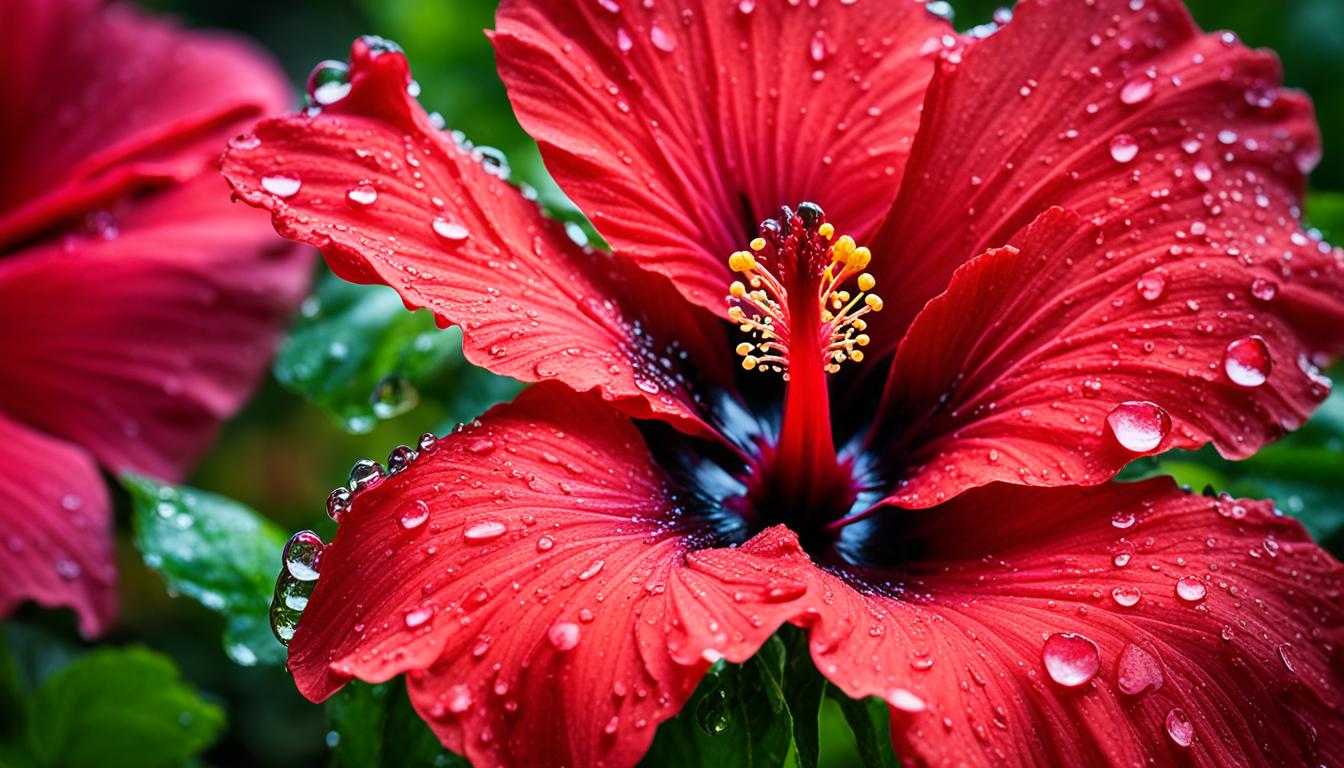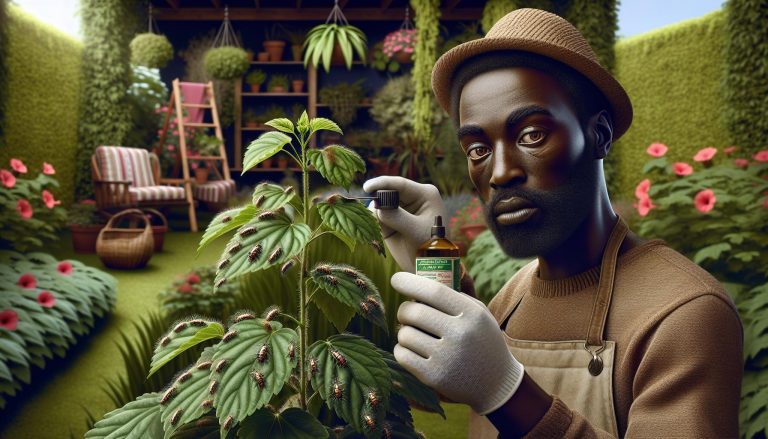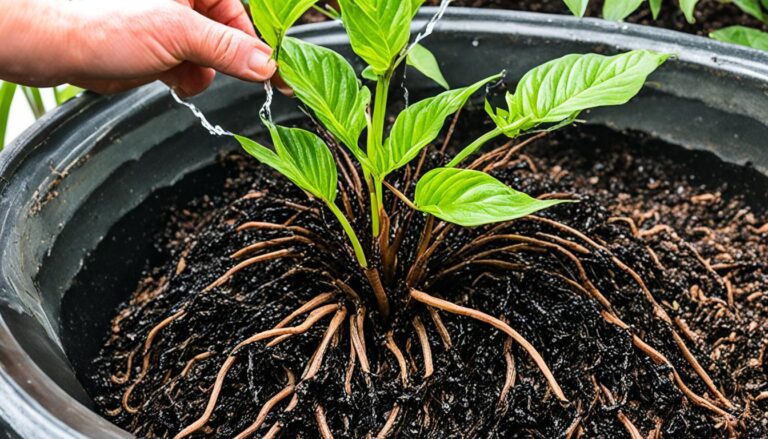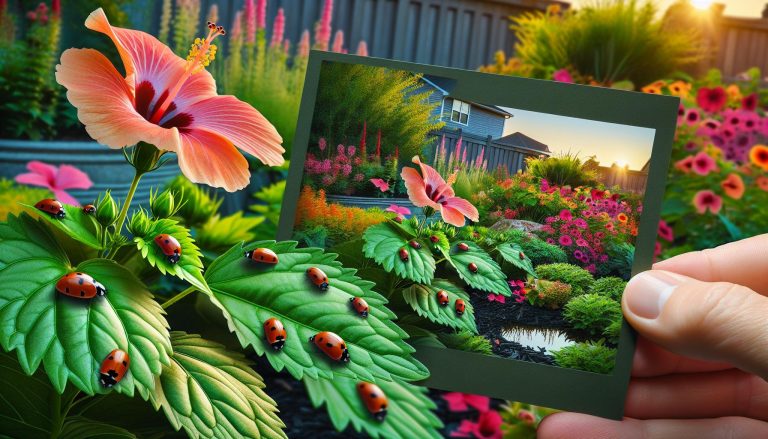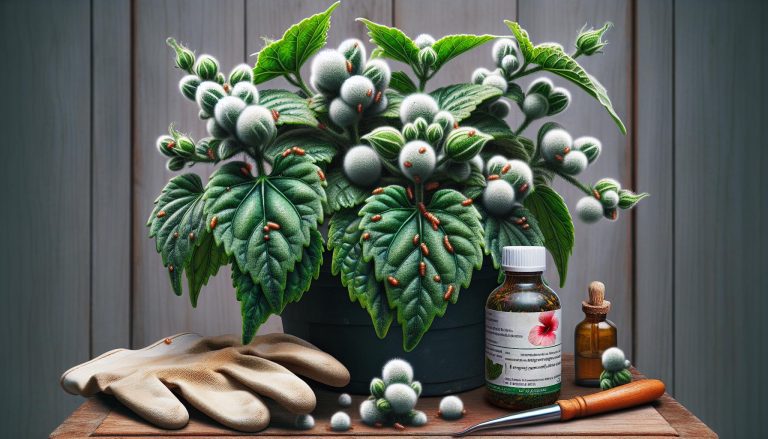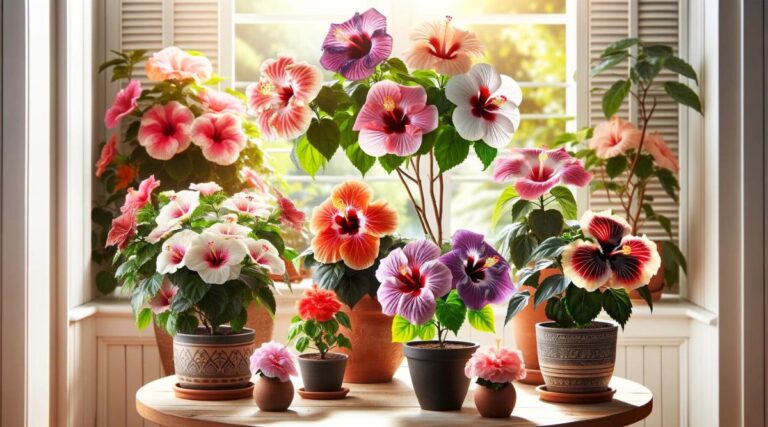Luna Red Hibiscus Care: Thrive with Tips & Tricks
Imagine stepping into your backyard on a warm summer morning, greeted by a burst of vibrant red blooms that seem to dance in the gentle breeze. The sight of these stunning flowers instantly uplifts your spirit and brings a sense of joy and tranquility to your day. This is the magic of the Luna Red Hibiscus.
With its deep burgundy red petals and creamy-white stamens, the Luna Red Hibiscus is a true showstopper. But there’s more to this perennial plant than just its enchanting beauty. It’s a symbol of resilience, a reminder that even in the harshest conditions, there is always the potential for growth and transformation.
Whether you’re a novice gardener or an experienced plant enthusiast, caring for the Luna Red Hibiscus can be a rewarding experience. In this article, we’ll dive into the tips and tricks that will help you nurture this tropical beauty and create a flourishing oasis in your own backyard.
Key Takeaways:
- Providing full sun exposure is crucial for the Luna Red Hibiscus to bloom to its full potential.
- Consistently moist, organically rich soils are ideal for this plant’s growth and overall well-being.
- Regular deadheading and spring pruning help maintain the plant’s neat appearance and encourage continuous blooming.
- The Luna Red Hibiscus is versatile and can be used in perennial borders, rain gardens, and other moist areas.
- Proper pest and disease management, along with seasonal adjustments, are essential for the plant’s health and longevity.
Planting and Growth
The Luna Red Hibiscus, also known as Hibiscus rosa-sinensis Luna Red, is a vibrant and beautiful addition to any garden. Understanding its planting and growth requirements is crucial for its success.
Plant Size: The Luna Red Hibiscus typically grows with an upright habit and can reach a height of 2-3 feet, with a width of 24 inches.
Sunlight Requirements: This hibiscus plant thrives in full sun and produces the best flowers when grown in this condition. However, it can tolerate some light shade.
Soil Preference: The Luna Red Hibiscus prefers average to wet soils that are consistently moist. It thrives in organically rich soils, which contribute to larger flowers and lush foliage.
Watering: Regular watering is essential for the Luna Red Hibiscus to maintain its moisture requirements. Providing adequate hydration to the plant will result in vibrant blooms and healthy growth.
Protection from Wind: Strong winds can cause damage to the plant. It is important to provide some form of protection, such as planting it in a sheltered location or using a windbreak.
| Plant Size | Sunlight Requirements | Soil Preference | Watering | Protection from Wind |
|---|---|---|---|---|
| 2-3 feet tall, 24 inches wide | Thrives in full sun, tolerates light shade | Prefers consistently moist, organically rich soils | Regular watering for vibrant blooms | Provide protection from strong wind |
By following the proper planting and growth guidelines, you can ensure that your Luna Red Hibiscus thrives and blesses your garden with its vivid red blooms. In the next section, we will explore planting locations and various uses for this versatile plant.
Planting Locations and Uses
The Luna Red Hibiscus is a versatile plant that can be used in various garden settings. Whether you’re looking to enhance perennial borders or create stunning displays in rain gardens, this plant is sure to impress. Here are a few ideas for planting and using the Luna Red Hibiscus:
In Perennial Borders
The Luna Red Hibiscus is a fantastic addition to perennial borders, where its dramatic summer blooms can steal the show. Planted alongside other perennials, it adds a pop of color and creates a focal point in the garden. Its deep burgundy red flowers stand out against the green foliage, creating a visually stunning contrast. Not only does it add beauty, but it also attracts pollinators, making your garden a buzzing haven for bees and butterflies.
In Rain Gardens
Looking to create a rain garden that’s both functional and beautiful? The Luna Red Hibiscus is an excellent choice. Its tolerance for moist conditions makes it ideal for planting near streams, ponds, or in bog gardens. The plant can withstand periodic flooding and thrive in these areas, adding vibrant color and texture to your rain garden. Its large, showy flowers will brighten up the space and create a stunning visual display, even after heavy rainfall.
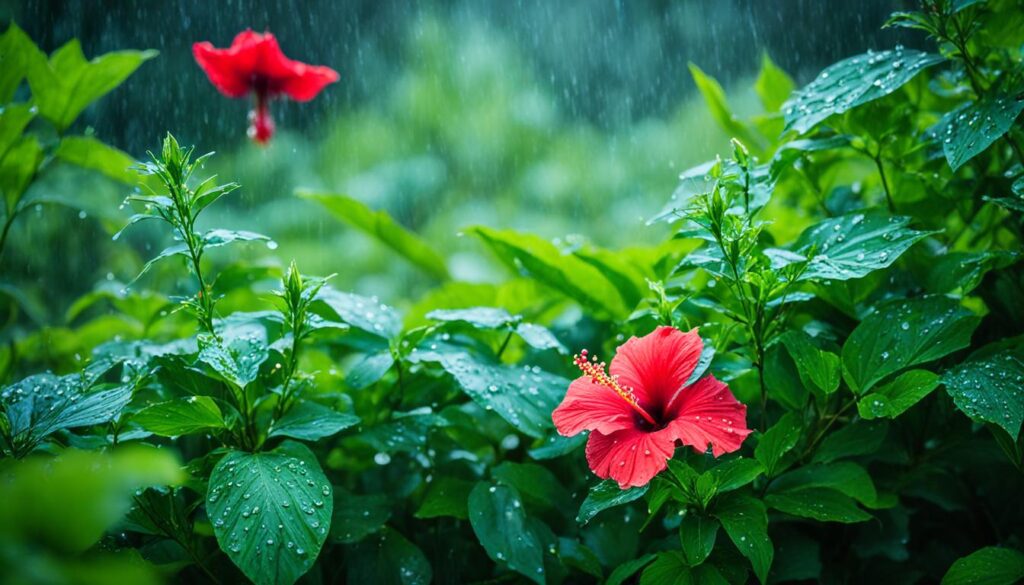
As you can see, the Luna Red Hibiscus offers versatility and beauty in different garden settings. Its striking flowers and ability to tolerate moist conditions make it a valuable addition to perennial borders or rain gardens. Consider incorporating this stunning plant into your garden and enjoy the vibrant blooms it brings.
Plant Maintenance
To keep your Luna Red Hibiscus looking its best, proper plant maintenance is essential. By following a few simple care tips, you can ensure that your hibiscus remains healthy and vibrant throughout the growing season.
Deadheading Hibiscus Flowers
Regular deadheading of spent flowers is an important task to promote continuous blooming and prevent seed production. Deadheading involves removing the faded flowers from the plant, which encourages the growth of new buds and prolongs the blooming period. To deadhead your Luna Red Hibiscus, simply pinch off the faded blooms at the base using your fingers or garden shears. Be sure to remove the entire flower, including the stem, to prevent seed development.
Cutting Down Hibiscus in Spring
In early spring, before new growth appears, it is recommended to cut down your Luna Red Hibiscus to promote fresh growth and maintain its shape. This pruning method is also known as “renewal pruning.” Using sharp and clean pruning shears, cut the plant back to a height of 6 to 8 inches above the ground. This will encourage new shoots to emerge from the base of the plant, resulting in a compact and well-branched growth habit.
Mulching for Winter Protection
In the first winter after planting your Luna Red Hibiscus, it is important to provide adequate protection against the cold. One effective method is heavy mulching around the base of the plant. Apply a layer of organic mulch, such as straw or wood chips, around the root zone to insulate the plant and prevent freezing. Mulching also helps retain moisture and reduces weed growth. Be sure to leave a small gap around the plant’s stem to prevent rotting.
| Plant Maintenance Tasks | Frequency |
|---|---|
| Deadheading spent flowers | Regularly throughout the blooming season |
| Cutting down the plant in spring | Once a year, before new growth appears |
| Mulching for winter protection | Annually, in the first winter after planting |
By incorporating these plant maintenance practices into your routine, you can ensure that your Luna Red Hibiscus thrives and rewards you with an abundance of stunning flowers. With proper care and attention, your hibiscus plant will be a focal point in your garden for years to come.
Pest and Disease Management
The Luna Red Hibiscus is a resilient plant, but it can still fall victim to common pests and diseases. By actively monitoring and taking appropriate measures, you can protect your plant and ensure its health and vitality.
Common Hibiscus Pests
Hibiscus plants are susceptible to various pests, including aphids, scale insects, whiteflies, and Japanese beetles. These pests can cause damage to the leaves, flowers, and stems of the plant, affecting its overall appearance and health.
To control these pests, consider using insecticidal soap or introducing beneficial insects like ladybugs or lacewings. These natural predators can help keep pest populations in check, reducing the need for chemical treatments.
Hibiscus Plant Diseases
Like any plant, the Luna Red Hibiscus is prone to certain diseases. Common diseases that can affect hibiscus plants include blight, canker, rust, and leaf spots. These diseases can cause discoloration, wilting, and lesions on the foliage, potentially impacting the plant’s growth and blooming.
To minimize the risk of disease, it’s important to practice proper sanitation and management techniques. Avoid overwatering, as excessive moisture can create a favorable environment for fungal growth. Provide adequate air circulation around the plant by spacing them appropriately, and remove any diseased or dead plant material promptly.
Regularly inspecting your Luna Red Hibiscus for signs of pests and diseases, and taking timely action when necessary, is key to maintaining its health and beauty.
Common Hibiscus Pests and Diseases
| Pests | Diseases |
|---|---|
| Aphids | Blight |
| Scale Insects | Canker |
| Whiteflies | Rust |
| Japanese Beetles | Leaf Spots |
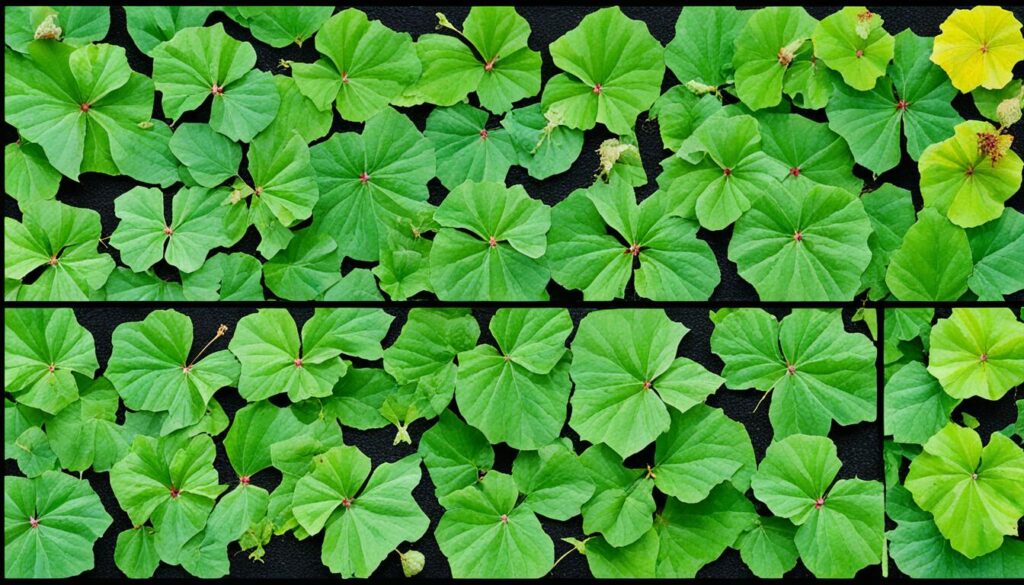
Best Planting Time and Winter Care
When it comes to planting the Luna Red Hibiscus, timing is key. The best time to plant this vibrant perennial is before the scorching heat of summer sets in. By planting in late spring or early summer, you allow the plant to establish strong roots and acclimate to its new environment before the hot weather arrives. This helps ensure its long-term success and healthy growth.
Winter care is equally important to protect your Luna Red Hibiscus during the cold months. Mulching heavily around the plant in its first winter provides insulation and shields it from harsh temperatures. Adding a thick layer of organic mulch, such as shredded bark or straw, helps retain moisture, regulate soil temperature, and protect the plant’s roots from frost or freezing conditions.
To offer even more winter protection, consider wrapping the plant in burlap or moving it to a sheltered location, such as a garage or shed. These additional measures can further safeguard your plant from extreme cold and reduce the risk of winter damage.
By taking these steps to protect your Luna Red Hibiscus during winter, you increase its chances of surviving and thriving come spring. Remember, the cold weather can be challenging for tropical plants like the Luna Red Hibiscus, so providing adequate winter care is crucial for its long-term health and blooming success.
Winter Care Checklist:
- Apply a thick layer of organic mulch around the base of the plant
- Consider wrapping the plant in burlap
- Move the plant to a sheltered location, if possible
- Monitor soil moisture and water sparingly during winter
Winter Care Dos and Don’ts:
| Do: | Don’t: |
|---|---|
| Provide winter protection with mulching | Overwater the plant during winter |
| Monitor soil moisture and water sparingly when necessary | Expose the plant to harsh winter winds without protection |
| Wrap the plant in burlap for added insulation | Allow the plant to sit in soggy, waterlogged soil |
Sunlight Requirements
The Luna Red Hibiscus is a sun-loving plant that requires six to eight hours of direct sunlight every day to produce its full, vibrant blooms. Positioning the plant in a location where it can receive ample daylight is crucial for its optimal growth and flowering.
When choosing a spot for outdoor cultivation, it is best to select an area that receives full sun for the majority of the day. Morning sunlight is preferable over harsh afternoon rays as it provides a gentle and warm glow that the plant thrives in.
For indoor cultivation, south and west-facing windows offer the best sunlight for the Luna Red Hibiscus. These windows receive the most sunlight throughout the day, allowing the plant to soak up the necessary rays for its growth and blooming.
When growing the plant indoors, it is important to strike a balance between direct and indirect sunlight. Direct sunlight for extended periods can lead to leaf burn, while too much shade can limit the plant’s ability to produce flowers.
To diffuse the intense light when growing the Luna Red Hibiscus indoors, sheer curtains or blinds can be used. These provide a filter that softens the sunlight, ensuring the plant receives the right amount of illumination without the risk of scorching the leaves.
Overall, providing the Luna Red Hibiscus with the appropriate amount of sunlight, whether outdoors or indoors, is key to its successful growth and blooming. Finding the right balance between direct and indirect light helps maintain the plant’s health and promotes its stunning display of deep burgundy red flowers.
| Sunlight Requirements for Luna Red Hibiscus | Description |
|---|---|
| Outdoor Cultivation | Position the plant in an area with full sun exposure, preferably in a spot that receives morning sunlight. |
| Indoor Cultivation | Place the plant near south or west-facing windows, ensuring it receives ample sunlight throughout the day. |
| Direct vs. Indirect Sunlight | Strike a balance between direct and indirect sunlight to prevent leaf burn while still promoting flowering. |
| Using Sheer Curtains or Blinds | Install sheer curtains or blinds to diffuse intense sunlight when growing the plant indoors. |
Dealing with Strong Sunlight
Intense midday heat can be harmful to the health of your Luna Red Hibiscus. When exposed to strong sunlight, the plant may suffer from scorched leaves and a lack of flowers. If you notice wilting or bleached leaves, it is essential to take action to protect your hibiscus from the intense sunlight.
A simple and effective way to shield your Luna Red Hibiscus from the harsh sun is by providing shade during the hottest part of the day. Using shade cloths or creating temporary shade structures can help mitigate the effects of intense sunlight and maintain the plant’s health and blooming.
By strategically positioning shade cloths or creating shade structures, you can create a shaded area for your hibiscus, effectively protecting it from the direct rays of the sun. This will help prevent wilting, leaf burn, and other issues caused by excessive exposure to intense sunlight.
Remember to choose a shade cloth that provides the right level of shade for your hibiscus plants. The cloth should block a sufficient amount of sunlight without completely obstructing natural light. This will ensure that your plants still receive the necessary amount of light for photosynthesis and growth.
Creating shade for your hibiscus plants can also be achieved by using temporary shade structures. These structures can be made of lightweight materials such as bamboo poles or fabric stretched over a frame. They can be easily moved or adjusted to provide the desired amount of shade throughout the day.
Benefits of Providing Shade:
- Protecting hibiscus from intense sunlight: Shade helps prevent sunburn and heat stress, preserving the health and vitality of your Luna Red Hibiscus.
- Enhancing blooming: By protecting your hibiscus from intense sunlight, you can encourage continued blooming and prolong the lifespan of the flowers.
- Maintaining foliage health: Shielding the plant from excessive sun exposure helps prevent leaf scorch and ensures the leaves retain their vibrant green color.
Shade Cloth or Shade Structures:
The choice between shade cloth and shade structures depends on your preferences and gardening needs. Shade cloths are versatile and can be easily adjusted or removed as needed. Shade structures, on the other hand, offer more permanent solutions and can be customized to fit your garden’s aesthetics.
Consider the specific requirements of your Luna Red Hibiscus and the environment in which it is growing when deciding which shade option to use. Whether you opt for a shade cloth or a shade structure, the key is to provide adequate protection from intense sunlight while still allowing the plant to receive the light it needs to thrive.
By taking steps to shield your Luna Red Hibiscus from intense sunlight, you can ensure its health and well-being. Protecting your hibiscus with shade cloths or temporary shade structures will help maintain its beauty and allow you to enjoy its stunning blooms for a longer period.
Indoor Sunlight Strategies
When growing the Luna Red Hibiscus indoors, providing adequate sunlight is crucial for its health and growth. South and west-facing windows offer the best natural light, especially during the shorter days of fall and winter. Placing the plant in a location where it receives ample daylight, preferably with morning light, will ensure optimal growth.
To promote even growth and prevent the plant from leaning towards the light source, it is recommended to rotate the Luna Red Hibiscus quarter turns with each watering. This rotation will help the plant develop a well-proportioned silhouette. Additionally, using sheer curtains or blinds can help regulate the amount of light the plant receives, preventing it from getting scorched.
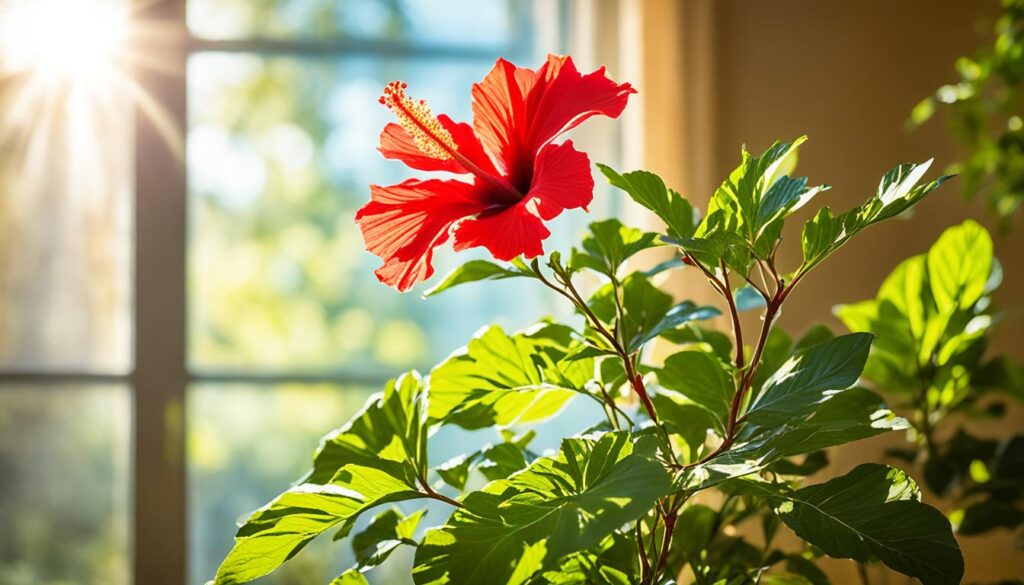
Benefits of Rotating Indoor Hibiscus Plants
Rotating the Luna Red Hibiscus indoors has numerous benefits. By rotating the plant, you ensure that all sides receive an equal amount of light, preventing lopsided growth. This practice also encourages the stems to develop strength and resilience, resulting in a well-balanced plant. Additionally, rotating the plant helps stimulate airflow around the leaves, reducing the risk of fungal issues and ensuring overall plant health.
Flowering and Light Requirements
Light plays a crucial role in the blooming of the Luna Red Hibiscus. To produce stunning flowers, the plant requires the right amount and intensity of light. Outdoor plants thrive in full sun, while indoor plants benefit from the natural light provided by south and west-facing windows.
Adjusting the lighting according to the seasons is essential to maintain a healthy bloom cycle. During autumn and winter, when the days are shorter, it’s important to modify the light exposure. Consistency in light is key to ensure a robust and vibrant blooming display.
To illustrate the impact of light on hibiscus blooms, below is a comparison of how indoor and outdoor hibiscus plants respond to different lighting conditions:
| Lighting Conditions | Outdoor Hibiscus | Indoor Hibiscus |
|---|---|---|
| Full Sunlight | Thrives and produces abundant, vibrant blooms | Requires ample sunlight from south or west-facing windows to promote blooming |
| Partial Sunlight | May result in fewer blooms and less intense flower color | Insufficient light may lead to spindly growth and limited blooming |
| Low Light | Produces weak growth and scarce blooms | Struggles to bloom and may exhibit yellowing of leaves |
As shown in the table, providing the right light conditions is essential for the Luna Red Hibiscus to reach its full blooming potential. Whether grown indoors or outdoors, ensuring consistent and appropriate lighting throughout the year will lead to a magnificent display of deep burgundy red flowers.
Using Grow Lights
When it comes to caring for your Luna Red Hibiscus, adequate light is crucial for its growth and blooming. However, in areas with limited natural sunlight or during the winter months, using grow lights can provide the supplemental light that your hibiscus plants need to thrive.
Grow lights for hibiscus plants come in various types, but LED grow lights are highly recommended for their energy efficiency and cool operation. They prevent leaf burn and offer a wide range of wavelengths that simulate natural sunlight. Full-spectrum LEDs are particularly beneficial as they provide the necessary light spectrum for optimized plant growth.
Fluorescent lights are another option for growing hibiscus plants indoors. While they are less efficient than LEDs, they can still provide adequate light for your hibiscus. However, it’s important to position the grow lights properly to ensure optimal light exposure. Place the lights a few inches above the plants and adjust the height as the plants grow to ensure they receive the right amount of light.
Choosing the right grow lights for your hibiscus plants is essential to their overall health and blooming. Consider factors such as light output, energy efficiency, and heat generation when making your selection. LED grow lights are a popular choice due to their effectiveness and longevity.
Comparison of Grow Light Options
| Grow Light Type | Advantages | Disadvantages |
|---|---|---|
| LED Grow Lights | – Energy-efficient – Cool operation prevents leaf burn – Full-spectrum options available |
– Higher initial cost – Might have limited coverage area |
| Fluorescent Lights | – Lower initial cost – Can provide adequate light |
– Less energy-efficient – Less effective than LEDs |
When using grow lights, remember to closely monitor the light intensity and duration to avoid overexposing your hibiscus plants. The goal is to replicate natural sunlight as closely as possible to ensure healthy growth and blooming throughout the year.
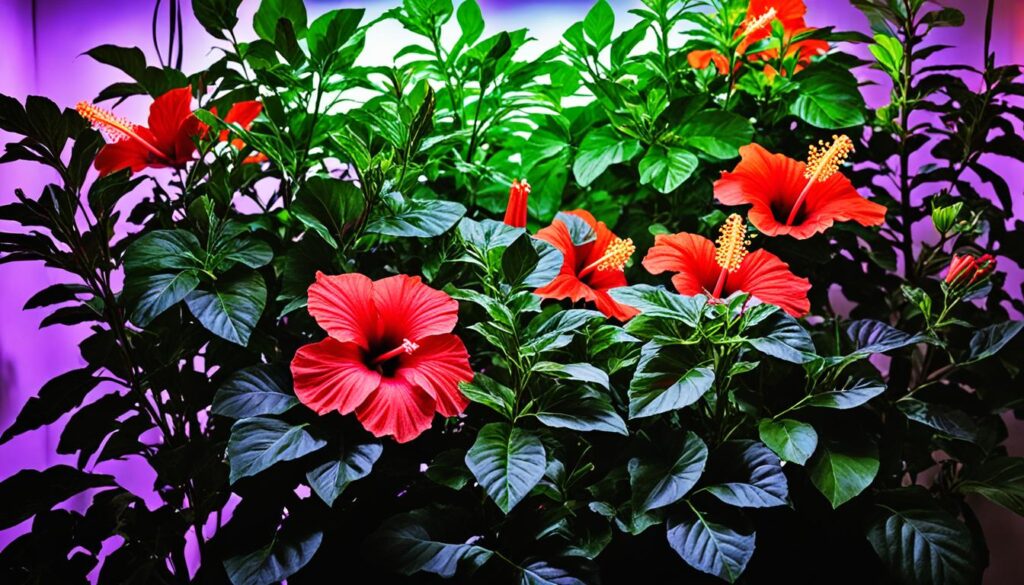
With the right grow lights and proper care, you can enjoy the beauty of your Luna Red Hibiscus even in locations with limited sunlight or during the darker months. Supplementing natural light with grow lights allows you to create an optimal growing environment for your hibiscus plants and enjoy their vibrant blooms year-round.
Growing Conditions and Temperature
The Luna Red Hibiscus is a tropical plant that thrives in specific temperature conditions.
For optimal growth and vibrant blooms, it is important to provide the plant with a stable temperature range. The ideal temperature for the Luna Red Hibiscus is between 65°F to 75°F (18°C to 24°C).
Stable temperatures within this range promote healthy growth and encourage the plant to produce its stunning deep burgundy red flowers.
Fluctuations in temperature can stress the plant and result in poor growth and fewer flowers. It is important to monitor the plant for signs of temperature stress, such as wilting or yellowing leaves.
If the temperature is outside the ideal range, adjustments should be made to provide a more suitable environment for the plant. This can include moving the plant to a different location where the temperature is more favorable or using shade cloths or heaters to stabilize the temperature.
By maintaining the ideal temperature range, you can ensure that your Luna Red Hibiscus thrives and displays its full beauty throughout the blooming season.
Ideal Temperature Range for Luna Red Hibiscus
| Temperature | Ideal Range |
|---|---|
| Fahrenheit | 65°F to 75°F |
| Celsius | 18°C to 24°C |
Temperature Stress and Consequences
Extreme temperatures can have detrimental effects on the Luna Red Hibiscus. Heat stress in hibiscus plants, caused by high temperatures, can lead to leaf scorch and bud drop. Additional protection, such as shade and adequate irrigation, should be provided during hot weather to prevent heat stress. Cold stress in hibiscus plants, especially during frost, can damage or kill the plant. Mulching and providing shelter or coverings are effective ways to protect the plant from freezing temperatures and frost. Adapting care to seasonal changes is necessary to provide appropriate protection to the plant.
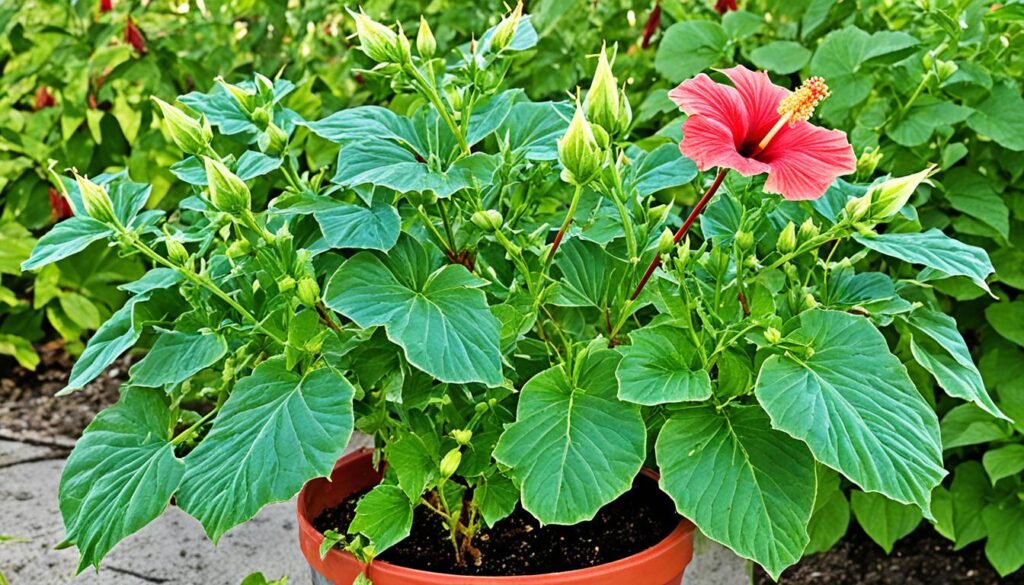
| Temperature Stress | Consequences |
|---|---|
| Heat stress | Leaf scorch and bud drop |
| Cold stress | Damage or death of the plant |
Seasonal Adjustments and Humidity
Proper care for the Luna Red Hibiscus requires adjusting its care routine based on the changing seasons. By providing the necessary protection and maintaining appropriate humidity levels, you can help your hibiscus plant thrive throughout the year.
Seasonal Care for Hibiscus Plants
During the hot summer months, it’s essential to provide extra protection to your Luna Red Hibiscus. Shield it from the scorching sun by providing shade during the hottest part of the day. You can use shade cloths or create temporary shade structures to protect the plant from excessive heat. Additionally, ensure the plant receives adequate hydration by watering it regularly. Keep the soil moist but avoid overwatering, as it can lead to root rot.
In contrast, winter care for hibiscus plants involves protecting them from the cold and frost. When temperatures drop below freezing, it’s crucial to provide insulation to prevent damage. Consider mulching heavily around the base of the plant to protect its roots from the cold. You can also wrap the plant with burlap or move it to a sheltered location to shield it from harsh winter conditions.
Humidity for Hibiscus Plants
Maintaining the proper humidity levels is crucial for the overall health of your Luna Red Hibiscus. These tropical plants thrive in moderate to high humidity environments. Aim to keep the humidity levels between 60% and 70% to complement the warmth that the plant enjoys.
However, it’s important to strike a balance and avoid excessive moisture, as it can lead to fungal issues. Monitor the soil moisture and ensure it remains moist but not waterlogged. Proper drainage is key to prevent water accumulation around the roots, which can promote fungal growth.
To increase humidity around your hibiscus plant, you can use a humidifier or place a tray of water near it. As the water evaporates, it will create a more humid microclimate around the plant.
Remember to monitor the humidity levels in your home or garden and adjust accordingly. Regularly check the leaves for signs of stress, such as wilting or browning, which may indicate insufficient humidity or excess moisture.
By adapting your care routine to the changing seasons and maintaining the proper humidity levels, you can ensure that your Luna Red Hibiscus remains healthy and continues to produce its stunning burgundy red flowers throughout the blooming season.
Transitioning with the Seasons
As the seasons change, it is important to make adjustments to the care of your Luna Red Hibiscus. This will ensure that your plant remains healthy and continues to produce vibrant blooms year-round.
Hibiscus Care by Season
During the winter months, it is crucial to protect your Luna Red Hibiscus from freezing temperatures. Consider covering the plant or moving it to a sheltered location to prevent damage. In the summer, focus on providing shade for your hibiscus to shield it from intense heat. Adequate hydration is also essential during this time to keep the plant thriving.
Year-Round Care for Hibiscus Plants
Consistency in care throughout the year is key to the success of your Luna Red Hibiscus. In addition to seasonal adjustments, pay attention to humidity levels. This tropical plant thrives in moderate to high humidity, which mimics its natural environment.
To summarize, by adapting your care routine to the changing seasons and maintaining the right humidity levels, you can ensure your Luna Red Hibiscus remains healthy and continues to produce stunning blooms all year long.
Take a look at the table below for a quick overview of hibiscus care by season:
| Season | Care |
|---|---|
| Winter | Protect from freezing temperatures |
| Spring | Prune and fertilize |
| Summer | Provide shade and ample hydration |
| Fall | Prepare for dormancy |
Conclusion
In conclusion, proper care for the Luna Red Hibiscus is essential for it to thrive and produce stunning blooms. Paying attention to its specific needs regarding sunlight, temperature, and humidity is crucial. Providing the plant with full sun exposure, maintaining a stable temperature range of 65°F to 75°F, and ensuring appropriate humidity levels will create the ideal growing conditions.
Regular maintenance tasks play a vital role in the plant’s overall health and appearance. Deadheading spent flowers and cutting down the plant in spring contribute to its continued blooming and neat appearance. These simple maintenance routines keep the Luna Red Hibiscus robust and vigorous.
With the right care, the Luna Red Hibiscus will reward gardeners with a spectacular display of deep burgundy red flowers throughout the blooming season. So go ahead and create a lush and vibrant garden with this beautiful perennial plant.

